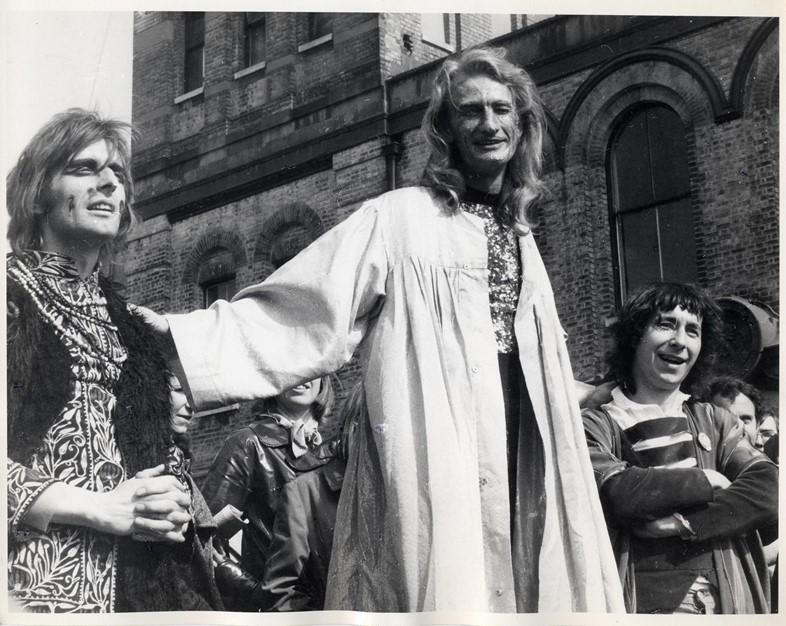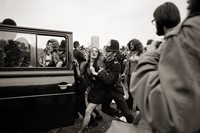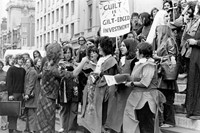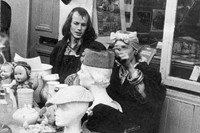A new exhibition at London’s Queercircle showcases rare documentary photography celebrating the radical drag queens of the UK Gay Liberation Front (GLF)
“That’s me and my friend Nicholas Bramble,” says Stuart Feather. “The man in the fishnets. He came as the Spirit of Porn.” It’s September 1971, and Stuart Feather is being thrown by police into a van wearing pearls and a dress and a wig. The UK Gay Liberation Front had staged a demonstration at the Festival of Light, a nationwide church campaign to re-criminalise homosexuality, make abortion illegal, and have stricter penalties on porn and prostitution. “It was at the Methodist Central Hall in Westminster,” Feather explains. “Mice were released. A group of nuns moved out the pews, lifted their skirts, and can-canned down the aisle. Others pulled the plugs in the basement and plunged half the hall into darkness. People were staggered.”
A photograph of the event is on view at Queercircle, a new LGBTQ+ cultural space on Greenwich Peninsula. Titled The Queens’ Jubilee, the exhibition showcases rare documentary photography celebrating the radical drag queens of the UK Gay Liberation Front (GLF), designed to mark the 50th anniversary of the first UK Pride March in 1972. “Over 50 per cent of dedicated LGBTQ+ spaces in London have closed in the last ten years,” says Ashley Joiner, Queercircle’s founder. “We now have an opportunity to collaborate on community-informed programmes to make positive, collective change.”
“I was really quite intrigued by the sense of power radical drag gave,” says Feather, who leads the exhibition. “It was visceral. The image and my gender was causing all this confusion.” The GLF began in New York in 1969, after pivotal riots at the Stonewall Inn. Founded in London the following year, the first step was to proclaim your sexuality – to come out. “We caused a lot of problems in the movement,” Feather explains. “We were said to be giving homosexuals a bad name. All we wanted was to show in a very clear way that we were gay. That was the message writ large on our body. So we were labelled radical femmes,” he laughs. “Better blatant than latent.”
GLF realised that homophobia stemmed from gender norms, from sexism and patriarchy. Still today, being punished for being gay often stems for one’s failure at being ‘a man.’ Radical queens, then, are pivotal. “We were more and more fed up with the games men were playing,” says Feather. “The women were complaining early on about misogyny. I thought about it a lot.” On display is a photograph of a demonstration outside Bow Street’s Magistrates Court. “We were asked to support the women on trial for causing mayhem at the 1970 Miss World Contest at the Royal Albert Hall,” Feather explains. They bombed it with flour. One of the signs reads: “HOMOSEXUALS SUPPORT WOMEN’S LIBERATION.”

The radical femmes marched through London with GLF in 1972, the first-ever Pride. Now 82 years old, Feather reflects on the event: “I’ve always seen Pride as our golden egg,” he says. “The profits could be used to support our charities, to support the young, the vulnerable, education. But now it’s gone corporate. The Conservatives hold all the shares. They’re claiming all the things that we started. The charities should be at the front of the march instead of these dreadful corporations. The fight now, if anything, is to regain control over our own events. That is the number one fight.”
The Queens’ Jubilee is on at Queercircle in Greenwich, London until 8 September 2022.






